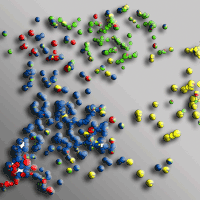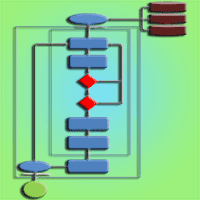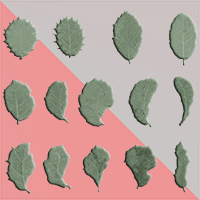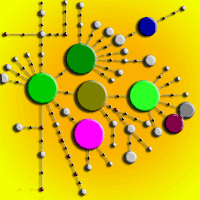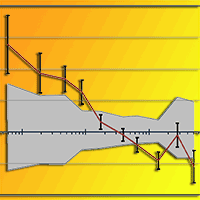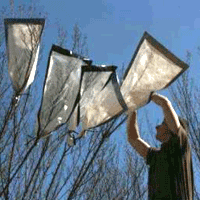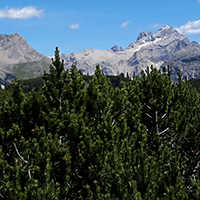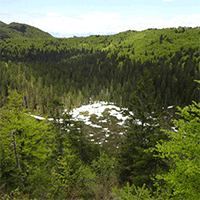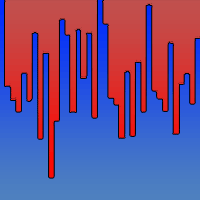
Molecular evidence of bidirectional introgression between Quercus suber and Quercus ilex
Unai López De Heredia, Héctor Sánchez, Alvaro Soto
iForest - Biogeosciences and Forestry, Volume 11, Issue 2, Pages 338-343 (2018)
doi: https://doi.org/10.3832/ifor2570-011
Published: Apr 18, 2018 - Copyright © 2018 SISEF
Research Articles
Collection/Special Issue: INCOTW - Sassari, Italy (2017)
International Congress on Cork Oak Trees and Woodlands
Guest Editors: Piermaria Corona, Sandro Dettori
Abstract
Cork oak and holm oak share a large part of their natural range, and are known to hybridize in mixed stands. This hybridization is supposed to have played a relevant role in the past history of cork oak. Previous research has reported that F1 hybrids are produced with holm oak acting as pollen recipient, therefore carrying holm oak chloroplast. Additionally, F1 hybrids have been assumed to be pollinated mostly by cork oak. Continued backcrossing of F1 hybrids with cork oak (supported by flowering phenology) could have created the organellar introgression patterns observed nowadays in Eastern Spain and Southern France cork oak populations. On the contrary, no organellar introgression has been detected in holm oak and multiple generation backcross individuals to holm oak have not been reported so far. In this work, we examined whether hybrids preferentially backcross with cork oak or with holm oak. To reach this goal, we genotyped by using eight microsatellite loci the progeny of four cork and four holm oak trees (33 and 44 half-siblings, respectively), and of four hybrids (468 half-siblings) collected over three years from a natural mixed population. We used the STRUCTURE software to estimate the proportion of the genotype of each seedling inherited from cork oak (qs) or from holm oak (qi). The ratio of the offspring q value over the mother q value helped determine the source of pollen that originated each acorn. Our results show for the first time that hybrid trees can be effectively pollinated by both parental species. Additionally, each hybrid tree was predominantly pollinated by the most abundant oak species in its vicinity. These results confirm the occurrence of bidirectional introgression, previously suggested for adult hybrid trees in the field, and point out the pattern of introgression in the seedlings could be most affected by the abundance of the parental species.
Keywords
Cork Oak, Holm Oak, Hybridization, Introgression, Microsatellites
Authors’ Info
Authors’ address
Héctor Sánchez
Alvaro Soto
GI Genética, Fisiología e Historia Forestal, Dpto. Sistemas y Recursos Naturales, ETSI Montes, Forestal y del Medio Natural, Universidad Politécnica de Madrid, Madrid (Spain)
Corresponding author
Paper Info
Citation
López De Heredia U, Sánchez H, Soto A (2018). Molecular evidence of bidirectional introgression between Quercus suber and Quercus ilex. iForest 11: 338-343. - doi: 10.3832/ifor2570-011
Academic Editor
Piermaria Corona
Paper history
Received: Jul 28, 2017
Accepted: Feb 20, 2018
First online: Apr 18, 2018
Publication Date: Apr 30, 2018
Publication Time: 1.90 months
Copyright Information
© SISEF - The Italian Society of Silviculture and Forest Ecology 2018
Open Access
This article is distributed under the terms of the Creative Commons Attribution-Non Commercial 4.0 International (https://creativecommons.org/licenses/by-nc/4.0/), which permits unrestricted use, distribution, and reproduction in any medium, provided you give appropriate credit to the original author(s) and the source, provide a link to the Creative Commons license, and indicate if changes were made.
Web Metrics
Breakdown by View Type
Article Usage
Total Article Views: 46042
(from publication date up to now)
Breakdown by View Type
HTML Page Views: 39351
Abstract Page Views: 2666
PDF Downloads: 3075
Citation/Reference Downloads: 9
XML Downloads: 941
Web Metrics
Days since publication: 2777
Overall contacts: 46042
Avg. contacts per week: 116.06
Citation Metrics
Article Citations
Article citations are based on data periodically collected from the Clarivate Web of Science web site
(last update: Mar 2025)
Total number of cites (since 2018): 11
Average cites per year: 1.38
Publication Metrics
by Dimensions ©
Articles citing this article
List of the papers citing this article based on CrossRef Cited-by.
References
L’llixi-Suergiu (Quercus morisii-borzi), nuova Quercia della Sardegna [The llixi-Suergiu (Quercus morisii-borzi), a new oak of Sardinia]. Nuovo Giornale Botanico Italiano 13 (1): 3-10. [in Italian]
Gscholar
Examen de las Encinas y demás arboles de la Peninsula Iberica que producen bellotas, con la designación de los que se llaman mestos [Analysis of holm oaks and other acorn-producing trees in the Iberian Peninsula, with the description of the so-called “mestos”]. D. Jose M. Geofrin Ed., Sevilla, Spain, pp. 16. [in Spanish]
Gscholar
Evidence for hybridization between sympatric holm oak and cork oak in Spain based on diagnostic enzyme markers. In: “Quercus ilex L. Ecosystems: Function, Dynamics and Management” (Romane F., Terradas J eds). Advances in Vegetation Science, vol. 13, Springer, Dordrecht, Netherlands, pp. 115-118.
CrossRef | Gscholar
Un mesto italiano y varios mestos espanoles [An Italian and several Spanish “mestos”]. Revista Montes 114: 477-486. [in Spanish]
Gscholar
Estudio de la estructura de masa de una dehesa de encina con alcornoque en “El Deheson del Encinar” (Toledo) [Study of the stand structure of a cork oak and holm oak open woodland in “El Dehesón del Encinar” (Toledo)]. Master Thesis, Universidad Politécnica de Madrid, Madrid, Spain, pp. 78. [in Spanish]
Gscholar
SimHyb: a simulation software for the study of the evolution of hybridizing populations. Application to Quercus ilex and Q. suber suggests hybridization could be underestimated. iForest - Biogeosciences and Forestry 11 (1): 99-103.
CrossRef | Gscholar

